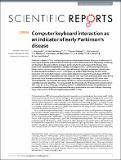Computer keyboard interaction as an indicator of early Parkinson’s disease
Author(s)
Montero, P.; Matarazzo, M.; Obeso, J. A.; Estépar, R. San José; Giancardo, Luca; Sanchez Ferro, Alvaro; Arroyo Gallego, Teresa; Butterworth, Ian Richard; Sanchez Mendoza, Carlos; Gray, Martha L; ... Show more Show less
DownloadComputer keyboard.pdf (640.3Kb)
PUBLISHER_CC
Publisher with Creative Commons License
Creative Commons Attribution
Terms of use
Metadata
Show full item recordAbstract
Parkinson’s disease (PD) is a slowly progressing neurodegenerative disease with early manifestation of motor signs. Objective measurements of motor signs are of vital importance for diagnosing, monitoring and developing disease modifying therapies, particularly for the early stages of the disease when putative neuroprotective treatments could stop neurodegeneration. Current medical practice has limited tools to routinely monitor PD motor signs with enough frequency and without undue burden for patients and the healthcare system. In this paper, we present data indicating that the routine interaction with computer keyboards can be used to detect motor signs in the early stages of PD. We explore a solution that measures the key hold times (the time required to press and release a key) during the normal use of a computer without any change in hardware and converts it to a PD motor index. This is achieved by the automatic discovery of patterns in the time series of key hold times using an ensemble regression algorithm. This new approach discriminated early PD groups from controls with an AUC = 0.81 (n = 42/43; mean age = 59.0/60.1; women = 43%/60%;PD/controls). The performance was comparable or better than two other quantitative motor performance tests used clinically: alternating finger tapping (AUC = 0.75) and single key tapping (AUC = 0.61).
Date issued
2016-10Department
Institute for Medical Engineering and Science; Massachusetts Institute of Technology. Department of Electrical Engineering and Computer Science; Massachusetts Institute of Technology. Research Laboratory of ElectronicsJournal
Scientific Reports
Publisher
Nature Publishing Group
Citation
Giancardo, L. et al. “Computer Keyboard Interaction as an Indicator of Early Parkinson’s Disease.” Scientific Reports 6.1 (2016): n. pag.
Version: Final published version
ISSN
2045-2322